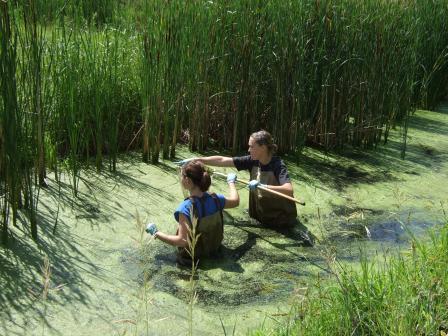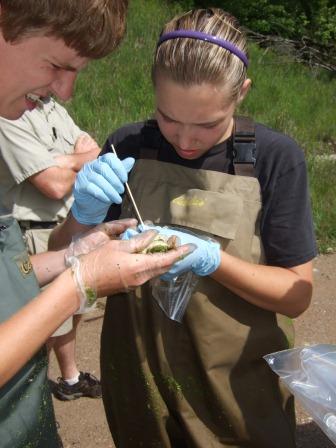On the ground
Through the education department of the Henry Doorly Zoo, instructors are able to receive training and supplies to contribute to the project. Groups of students select nearby sites and survey them for amphibians. Captured amphibians are swabbed for later DNA analysis, and aspects of both the amphibians and their environment are recorded and uploaded later to an online database.

In the lab
Samples are sent to Dr. Kerby’s lab for DNA analysis. Through a complex procedure, DNA is extracted from the sample swabs and then analyzed on a qPCR (quantitative polymerase chain reaction) machine. This machine allows us to not only detect the presence of the fungus, but also gives us a measure of the infection level of the sample. |
|
From the air
The data provided from both the ground and the lab are integrated into a larger database that can be tied to aerial photography maps (similar to how Google Maps operates). We are then able to incorporate other important datasets tied to locations such as climate, vegetation type, land use type, and so on to examine patterns at a much larger geographic scale.
On the internet
We then take all of our data and share it back to the students that collected it via a Facebook page. This page allows us to get feedback from students, answer questions about data collection or data entry. In addition, this builds a community of those involved in the project for everyone to see what different types of amphibians are out there and what patterns we can discover.
Summary
This project is very unique is several important ways.
Research is typically done on a much smaller scale due to a lack of resources. For instance,  graduate students in my laboratory can only monitor a limited number of survey sites at a time. Data collection from such a large number of surveys all done following the same methodology will provide scientists some much needed information on amphibians. The integration of all these data with newer mapping database technology will allow us to examine potential impacts like never before. graduate students in my laboratory can only monitor a limited number of survey sites at a time. Data collection from such a large number of surveys all done following the same methodology will provide scientists some much needed information on amphibians. The integration of all these data with newer mapping database technology will allow us to examine potential impacts like never before.
Science education is often done is a vacuum. While several science educators are amazing at what they do, they are clearly often limited by resources in what they can do. In addition, classes are typically doing great data collection but that data goes no further than an end of class report. In this project, students are able to contribute to an important project and communicate with scientists directly. In this way, they are able to see the entire process and actually be involved in scientific research.
As a biology professor, this project has great meaning for me not only professionally in terms of research, but also personally in terms of educating our future generations. As our technology advances, it becomes much easier for people to stay indoors and avoid the natural world entirely. The majority of biology students enrolled at universities are typically interested in health sciences. My belief is that this is primarily due to experience. Everyone encounters doctors, nurses, and dentists as they grow up, but very few have ever met a scientist. Given the inevitable importance of conservation and sustainability in the next generation’s world, it is of utmost important that we are able to generate the world’s best in solving these issues. It is my hope that by providing students an important outdoor scientific experiences, that we can significantly increase interest in this important and exciting discipline. |



 graduate students in my laboratory can only monitor a limited number of survey sites at a time. Data collection from such a large number of surveys all done following the same methodology will provide scientists some much needed information on amphibians. The integration of all these data with newer mapping database technology will allow us to examine potential impacts like never before.
graduate students in my laboratory can only monitor a limited number of survey sites at a time. Data collection from such a large number of surveys all done following the same methodology will provide scientists some much needed information on amphibians. The integration of all these data with newer mapping database technology will allow us to examine potential impacts like never before.